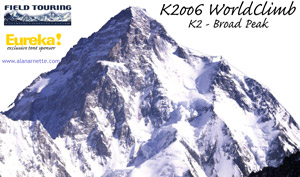
Broad Peak and K2
|
 |
K2oo6 WorldClimb Dispatches Broad Peak and K2 |
|||||||
|
||||||||

I always wanted to visit the Himalayas in Pakistan. The mountains are legendary: Gasherbrum I,Gasherbrum II, Nanga Parbat, Broad Peak and, of course, K2. The view from the confluence of three glaciers at Concordia is live postcard few get to see in person. In the summer of 2006, along with a team managed by Field Touring Alpine (FTA), I attempted Broad Peak (26,401') and planned to make a good effort on K2 (28,250'). I reached 21,000' on Broad or Camp 2 before abandoning the climb due to weakness that resulted from a severe bug I contracted on the trek in. The Karakorum ranges was magnificent and I was very lucky to have unbelievable weather for the month I spent there. I sent frequent dispatches using a system that includes a digital camera, PDA and sat phone. |
| Click here for the dispatch home and videos |
Click here for the dispatch home and videos
Karakorum HighwayPosted on June 5, 2006 06:33 AM U.S. Mountain Daylight TimeI had always heard about the Karakorum Highway. It was associated with famous names in history such as Marco Polo. Its reputation is one hazards, turns and death. In fact, it is said that 100 men died building every half mile of the road. Defined by the Greeks but made into a highway by the Pakistani and Chinese in the 1960s and 1970s it is an amazing journey. I had always heard about the Karakorum Highway. It was associated with famous names in history such as Marco Polo. Its reputation is one hazards, turns and death. In fact, it is said that 100 men died building every half mile of the road. Defined by the Greeks but made into a highway by the Pakistani and Chinese in the 1960s and 1970s it is an amazing journey. We new it was going to be a long day but we had no idea. We left Islamabad about 6:00AM on Saturday morning and arrived at the small village of Chilas at 9:00 that night. The highway follows the Indus River, a fast flowing river created from glacier melt. It was a muddy, turquoise mix that turned bright white in the fast moving rapids. While the scenery was stunning it was the bus driver that captured everyone’s attention. The highway is a never-ending series of sharp turns, blind corners, steep climbs and narrow escapes. It was a total mystery to everyone how two approaching drivers made the last second decision to pull left or right, speed up or slow down or give way. A serious game of chicken! We stopped often to let our stomach settles only to pick right up where we left off. However, it was at these stops that I began to see the Pakistani culture outside of the big city of Islamabad. First, we rarely saw a woman on the streets. This part of the culture was evident with men sitting on the streets and working on the highways but very rarely we saw a woman working in a field or looking out a door. We were asked not to take their pictures and when they saw someone with a camera they simply vanished – or at least it seemed that way. Next was the basic level of their lifestyle. In the Northern Areas, 80% of the people live an agricultural lifestyle – living on the plot of land where they grow rice and potatoes and raise their family. The villages were few and far between and consisted of basic adobe style buildings. It was here we witnessed the devastation of last year’s earthquakes. While we saw many crumpled homes and fallen walls, one stood out in my mind. A small dirt block building was home to ten people. The boys were outside and interacted with us. They smiled easily after a few minutes and my outstretched hand and smile to them. They let me take their pictures and soon started showing off for the camera. This was fun. Their sisters and adult women watched us carefully by peeking around the walls and from just inside the door. Like ghosts, they disappeared whenever I looked their way. Even when I finally got one’s attention and put down my camera, she made eye contact for a brief moment and then slipped away. The elders were quite different. The old men with their long beards or grey hair. They smiled toothless smiles and had a real twinkle in their eyes. Sometimes they laughed at my words in an expression of non-understanding. That night we spent in Chilias and Sunday took the nine more hours to reach Skardu. This is the largest city before the glaciers of the Himalayas end. We have spent the day resting up and finalizing our gear. We can buy a few things here such as climbing gear, clothes and food. But mostly everyone enjoyed not being in a bus! The Karakorum Highway took us back in time with the perspective of the present. Not much has changed for generations for this land and these people. The river is a constant in this area. It defines the valley, provides the basics for the plants, animals and people. While cars, busses and trucks crowd the highway, it is the people and the land that define the Karakorum highway. Tomorrow, Tuesday June 6, we take a 9-hour jeep ride to Askole – then the trek begins. Climb on! Alan |